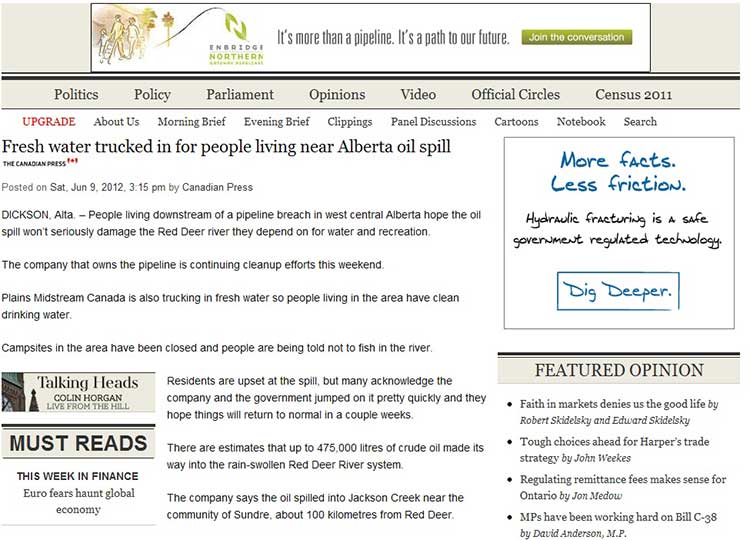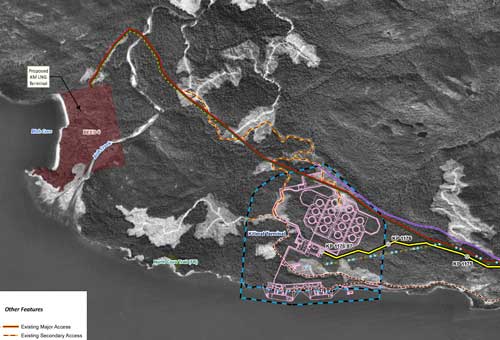
A group of biologists from across Canada have proposed a nine step program to sustain healthy waterways and fisheries not only in this country but around the world.
The key to clean waterways and sustainable fisheries is for the management plan to follow nine guiding principles of ecological water management, according to John Richardson, a professor in the Dept. of Forest and Conservation Sciences at the University of British Columbia, one of 15 freshwater biologists who created the framework to help protect fish and ecosystems into the future.
Fish habitats need waterways that are rich in food with places to hide from predators and lay eggs, according to the framework published on January 31 in the journal Environmental Reviews.
“Fish are strongly impacted when nutrients, sediments or pollutants are added to their habitat. We cannot protect fish without maintaining a healthy freshwater ecosystem,” Richardson,who led the policy section on protecting fish habitats, said in a UBC news release. Other policy sections addressed areas such as climate change and biodiversity.
Read the complete paper on the Environmental Reviews site.
Humans have put key waterways at risk because of land development and the loss of the vegetation along rivers and streams, Richardson said, adding connecting waterways are also critical for healthy ecosystems. “If fish can’t get to breeding or rearing areas because of dams, culverts, water intakes or other changes to their habitats, then the population will not survive,” he said.
With more pressure on Canada’s waterways, Richardson and his colleagues wanted to create a framework of evidence-based principles that managers, policy makers and others could easily use in their work. “It’s a made in Canada solution, but the principles could be applied anywhere in the world,” he said.
The paper says:
Freshwater ecosystems are among the most imperiled on Earth with extinction rates of freshwater fauna higher than for many other ecosystems and vastly exceeding historic background rates/ Freshwater is vital to humans, and clean water is rapidly becoming a limiting resource for many societies. The greatest threat to freshwater ecosystems is the loss or alteration of freshwater habitats through human development yet our societies and economy depend directly on the services provided by healthy freshwater ecosystems.
It also notes:
Most ecosystem services of fishes are supported by a diverse fauna, not by merely the few species directly favoured by humans. Humans live side-by-side with fishes and other aquatic organisms in watersheds, and we derive our quality of life from the health of these ecosystems.
The paper, which was supported in part by federal government financing, only touches on the controversy over the gutting of the environmental protection for Canadian waterways by the Harper government. It goes on to stay that the protests are not enough and more is needed:
Recent changes to Canadian fisheries policies have motivated responses by the public and the scientific community yet a broad contemporary scientific assessment of what is required to manage freshwater fisheries resources is lacking. A template of the core ecological concepts underlying sound fisheries policies, based on the best available science will support policy and management decisions and the design of monitoring programs to evaluate the success of these actions.
With more pressure on Canada’s freshwater ecosystems, Richardson and his colleagues wanted to create a framework of evidence-based principles that managers, policy makers and others could easily use in their work. “It’s a made in Canada solution, but the principles could be applied anywhere in the world,” he says.
Healthy freshwater ecosystems are shrinking and reports suggest that the animals that depend on them are becoming endangered or extinct at higher rates than marine or terrestrial species, says Richardson. Humans also depend on these ecosystems for basic resources like clean drinking water and food as well as economic activity from the natural resource sector, tourism and more.
The components of a successful management plan include:
- Protect and restore habitats for fisheries
- Protect biodiversity as it enhances resilience and productivity
- Identify threats to ecosystem productivity
- Identify all contributions made by aquatic ecosystems
- Implement ecosystem based-management of natural resources while acknowledging the impact of humans
- Adopt a precautionary approach to management as we face uncertainty
- Embrace adaptive management – environments continue to change so research needs to be ongoing for scientific evidence-based decision making
- Define metrics that will indicate whether management plans are successful or failing
- Engage and consult with stakeholders
- Ensure that decision-makers have the capacity, legislation and authority to implement policies and management plans.
These recommendations are based on nine principles of ecology:
- Acknowledge the physical and chemical limits of an ecosystem
- Population dynamics are at work and there needs to be a minimum number of fish for the population to survive
- Habitat quantity and quality are needed for fish productivity
- Connecting habitats is essential for movement of fish and their resources
- The success of freshwater species is influenced by the watershed
- Biodiversity enhances ecosystem resilience and productivity
- Global climate change affects local populations of fish
- Human impacts to the habitat affect future generations of fish
- Evolution is important to species survival




 In this map, the Enbridge pipeline is yellow with a black outline, the LNG pipeline is red. Where there are yellow and red alternating squares, that means the two pipelines will follow the same route. Solid orange lines are paved roads,broken orange lines are unpaved roads and the green lines are power lines.
In this map, the Enbridge pipeline is yellow with a black outline, the LNG pipeline is red. Where there are yellow and red alternating squares, that means the two pipelines will follow the same route. Solid orange lines are paved roads,broken orange lines are unpaved roads and the green lines are power lines. Just before the pipelines reach the service centre, they diverge, the yellow Enbridge pipeline following the road route around the periphery of the service centre, while the gas pipeline at first follows the route of the Pacific Trails Pipeline and then snakes off at the hydro substation. The two pipelines then run parallel just off Haisla Boulevard across from the Rio Tinto Alcan plant. The green line beside the two pipelines marks a hydro line that would be build to power the facilities.
Just before the pipelines reach the service centre, they diverge, the yellow Enbridge pipeline following the road route around the periphery of the service centre, while the gas pipeline at first follows the route of the Pacific Trails Pipeline and then snakes off at the hydro substation. The two pipelines then run parallel just off Haisla Boulevard across from the Rio Tinto Alcan plant. The green line beside the two pipelines marks a hydro line that would be build to power the facilities. The final map shows the Enbridge pipeline coming into the bitumen/condensate terminal with its large footprint, while the natural gas pipeline continues, crosses Bish Creek and then enters the Bish Cove KM LNG terminal. If the BC LNG terminal is built at North Cove, just west of the proposed Enbridge Northern Gateway facility, a branch pipeline would go from the main gas pipeline down to that facility. (There were indications at the June NEB hearings that negotiations were under way on “sharing” gas “molecules” between the two groups).
The final map shows the Enbridge pipeline coming into the bitumen/condensate terminal with its large footprint, while the natural gas pipeline continues, crosses Bish Creek and then enters the Bish Cove KM LNG terminal. If the BC LNG terminal is built at North Cove, just west of the proposed Enbridge Northern Gateway facility, a branch pipeline would go from the main gas pipeline down to that facility. (There were indications at the June NEB hearings that negotiations were under way on “sharing” gas “molecules” between the two groups). Footprint of the Enbridge Northern Gateway plant.
Footprint of the Enbridge Northern Gateway plant.
